5 Shocking Facts About Noise Levels in Everyday Life

You’re in a packed coffee shop, your top songs playing in your ears, or maybe you’re strolling on a crowded road, with cars zooming by. It seems typical, doesn’t it? But here’s the startling reality—many of these common sounds are too loud for your ears to handle . In truth, being around these noise levels for a long time could be harming your hearing without you knowing it.
Hearing loss doesn’t happen in a day; it sneaks up on you, and once you spot it, the harm is often irreversible. From blow dryers to city commutes, the noise in your day-to-day life might already put your hearing at risk. Are your ears out of harm’s way? Let’s reveal 5 surprising facts about everyday noise and how you can shield one of your most crucial senses.
1.Everyday Sounds That Could Hurt Your Ears and You Might Not Notice
Typical Sources of Loudness
People think that hearing damage comes from booming concerts or blasting fireworks. However, your average daily sounds can be just as bad in the long run. Check out some common culprits
a. City Hubbub:

That constant hum of city traffic hits over 70 decibels (dB). Then you’ve got those car horns and sirens that can jump to a whopping 100 dB or higher! Being around this non-stop in the city could wreck your ears over time.
b. Stuff in Your House:
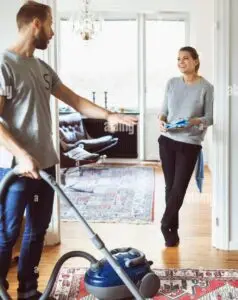
Bet you didn’t think about this, but when you whip up a smoothie, clean your carpet, or dry your hair, you’re dealing with 70-90 dB of noise. Sure, using these gadgets for just a bit might seem harmless, but if you keep at it without ear protection, you’re looking at some sneaky hearing damage.
c. Hustle and Bustle Spaces:

Position yourself in a restaurant, shopping complex, or a crammed lunchroom and you’ll find noise hitting the 80-90 dB mark. Talk about sneaky culprits for your ears feeling the pressure.
Why These Sounds Add Up?
The deal with noise goes beyond the sheer volume. It’s about how much time you hang around it too. Even if a sound aren’t all that loud, it could still do damage if it’s in your background for ages. Like, think about chilling for hours in a noisy cafe or working those home appliances without giving your ears a shield. Such scenarios are rough on your hearing after awhile.
How to Mitigate Everyday Noise
- Pick noise-cancelling headsets instead of cranking up the sound when you’re somewhere noisy.
- When you’re buying stuff for the house, go for machines that don’t make a lot of noise.
- Spend less time in super loud places and chill for a bit to give your ears a break.
2. When Noise Gets Risky: What’s the Volume Limit?
a. Getting the Lowdown on Decibels (dB)
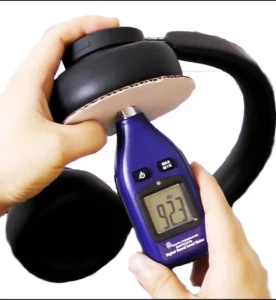
We measure sound intensity with decibels, and even a little uptick in dB can make noise way louder. Take this: speaking at regular volume hits 70 dB, which is double the volume of 60 dB, like the faint buzz in a silent house. Let’s scope out how normal noises stack up:
- 50-70 dB: It’s like quiet chat or the sound of rainfall – safe.
- 85 dB: Think of a lawnmower rumbling or busy roads – this is where it gets dicey if you hang around too long.
- 100+ dB: Cranked up tunes blaring car horns, or earbuds at full blast? Ouch, minutes is all it takes to hurt your ears.
b. Where’s the Safe Line?
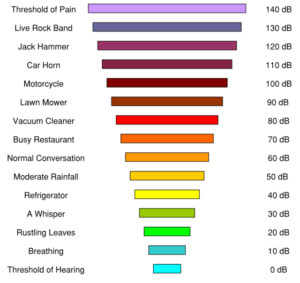
So, if you chat with health pros, they’ll tell ya once noise hits that 85 dB mark stick around beyond 8 hours and you’re gambling with your hearing. Every time the noise creeps up by 3 dB, you’ve got to slash your hangout time in half:
- 88 dB: You’re good for like 4 hours.
- 91 dB: Cut it to 2 hours.
- 94 dB: got an hour before it’s a no-go zone.
c. Tips to Remain Under the Risk Threshold

- Opt for apps on your phone to gauge the loudness in your environment.
- Get yourself some earplugs or earmuffs when you’re heading to gigs or doing garden chores.
- Make sure your gadget’s sound levels don’t go over the halfway mark to stay out of the danger zone.
3. Sound Dangers at the Workplace: Could the Noise in Your Job Harm Your Ears?
a. Jobs with High Noise Exposure
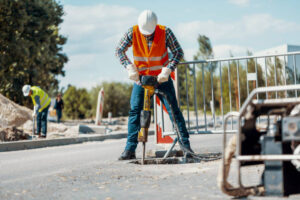
Some careers put employees in the line of some loud noises every day. Jobs like these include:
- Building Sites: Gear such as jackhammers and power drills can hit 120 dB, which is way louder than what’s safe.
- Manufacturing Areas: Always humming with machinery sounds close to 90-100 dB, these places are dangerous for your ears over time.
- Wide-Open Workspaces: Might not be super clear, but the non-stop talk and buzz in packed offices can wear out your hearing and stress you out.
b. Hearing Loss Over Time

- Folks working in loud spots tend to get hearing damage and stuff like ringing in their ears for good.
- Being around a ton of noise for a while can make you stressed, lose focus, and not get as much done.
c. How to Protect Your Hearing at Work?

- Pop on ear protection like earmuffs or plugs if loud noises surround you at work.
- Ask for less noisy equipment or walls that block sound if you can.
- Make sure you chill out in calm spots now and then to let your ears have a breather
4. The Truth About Headphones: When Tunes Turn Into Trouble for Your Ears
a. The Hazard of Listening High Volume
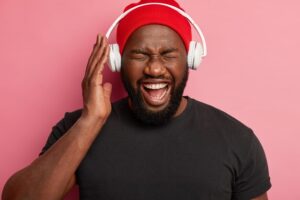
Headphones and little earbuds are super handy, but they pump music straight into your ear, and that could mess with your hearing big time. People often slip up by:
- Blasting tunes at the top volume, and that’s like over 100 decibels, by the way.
- Turning up the sound in loud places, which means going way louder.
- Keeping earbuds jammed in for too long without giving your ears a timeout.
b. The Importance of Listening Duration
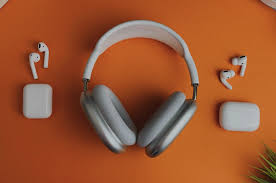
Even with a moderate volume, jamming out for too long can still tire out your ears. If you do this a lot, your ears might find it tougher to bounce back after a marathon music session.
c. Smarter Ways to Listen

- Stick to the 60/60 Rule: Cap your volume at 60% and listen for an hour at a stretch.
- Go for headphones that cover your ears and have tech to cancel out noise. This way, you won’t feel like cranking up your tunes too loud.
- Make sure to take regular time-outs for your ears after you’ve been rocking out to your playlist.
5. Spotting the Stealthy Signs: Early Heads-Up for Noise-Related Hearing Trouble
a. What’s the Deal with Noise-Related Ear Problems?
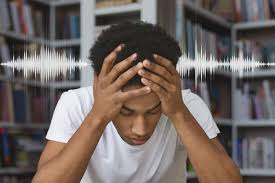
You won’t lose hearing all at once. Spotting the faint initial signs matters a ton, like:
- Tinnitus: Ears making sounds like ringing, buzzing, or hissing that stick around even when it’s quiet after loud noise.
- Trouble in Loud Places: Having a hard time picking up what people say when you’re somewhere with lots of background noise, like eateries or bashes.
Sounds Seem Blurry: Noises not coming through as sharp or as clear as they did before
b. Spotting Signs is Super Important

Noticing these signs has a big influence on stopping more harm. If you wait too long, you might end up with hearing that’s damaged for good.
c. What to Do When You Spot the Signs

Book a hearing test with a pro right away. Cut back on loud noise exposure pronto. When it’s noisy, pop in some earplugs to shield your ears.
Conclusion: Guard Your Ears Now

Sound’s all over the place, but you don’t have to let it mess with your ears. If you get how risky it is spot the early signs, and take steps to protect yourself, so your ears can stay sharp for a long time.
Taking care of your hearing? That’s all on you – well, your ears.
Start tweaking your daily routine now and you’ll keep digging those tunes you adore in the future.
